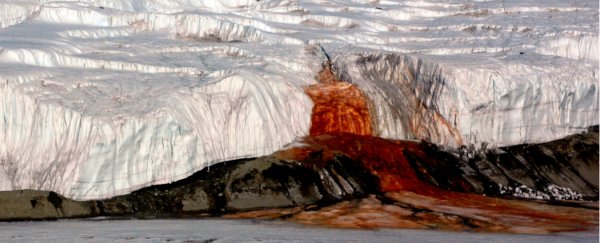If you're lucky enough to ever visit the McMurdo Dry Valleys in Antarctica, you're going to see some pretty bizarre things. Snowless valleys cutting into an otherwise frigid landscape; the longest river on the entire continent, named the Onyx River, and a five-storey-tall waterfall that spills bright, rusty red pigment all over the face of an enormous glacier.
The factors that all had to come together to make the blood falls happen started aligning around 5 million years ago. As sea levels rose and flooded the region, a salty lake formed in the area. Over millions of years, this salty lake was covered over by layers and layers of ice and snow, which accumulated into a massive glacier sitting on top of the lake, which now sat 400 metres underground. Cut off from the world, this lake became crazy salty - about three times saltier than sea water, which prevented it from ever freezing over.
It also happened to be incredibly rich in iron, as the churning lake scraped against its bedrock foundations and muddied its waters with the highly reactive mineral. Nowadays, when waters of the salty lake seep through a fissure in the glacier, they make contact with oxygen for the first time in millions of years, and the iron instantly rusts, leaving behind a blood-red stain on the glacier.
So far, not so mysterious. But the problem is that scientists aren't able to study the composition of the salty underground lake properly, because as soon as it makes contact with the outside air, it reacts and changes. So Jill Mikucki, a microbiologist from the University of Tennessee Knoxville in the US, came up with a solution, as described at The Antarctic Sun, published by the US Antarctica Program:
"The IceMole is a long rectangular metal box with a copper head and ice screw at one end capable of melting its way through ice – but not just straight down like a conventional electro-thermal drill. Differential heating at the tip allows IceMole to change directions. It looks a bit like a very large hypodermic needle poised to inoculate a glacier.
'It can drive curved trajectories through bulk ice. It can go sideways, up and down. If you want to reach any point, you can go there,' explained Dirk Heinen, a German physicist, while troubleshooting the first attempt to send the IceMole into Taylor Glacier that ended shortly after it began."
Using the aptly named IceMole, Mikucki's team has managed to extract the first ever samples from the blood falls lake, which will finally give them the chance to study the incredible microbes that can live in complete and utter darkness, devoid of oxygen, and with enough salt to kill any of us.
"It offers us a portal, or window, to the subglacial world … a sample of material from that ice-covered interior," Mikucki told The Antarctic Sun. "It tells us what might be living below the ice of the continent. There are no large animals or trees on Antarctica anymore. It's a microbial continent."
We can't wait to see what they find.
Sources: Gizmodo, The Antarctic Sun
